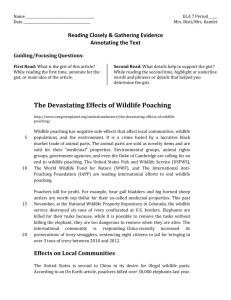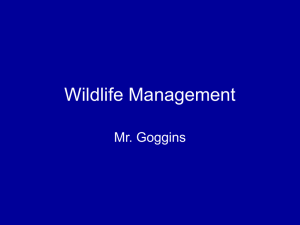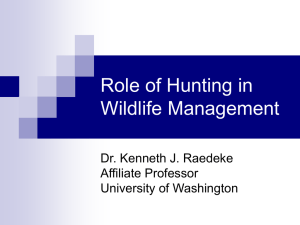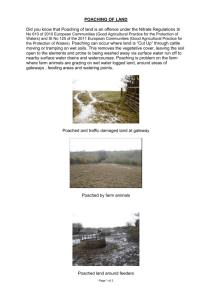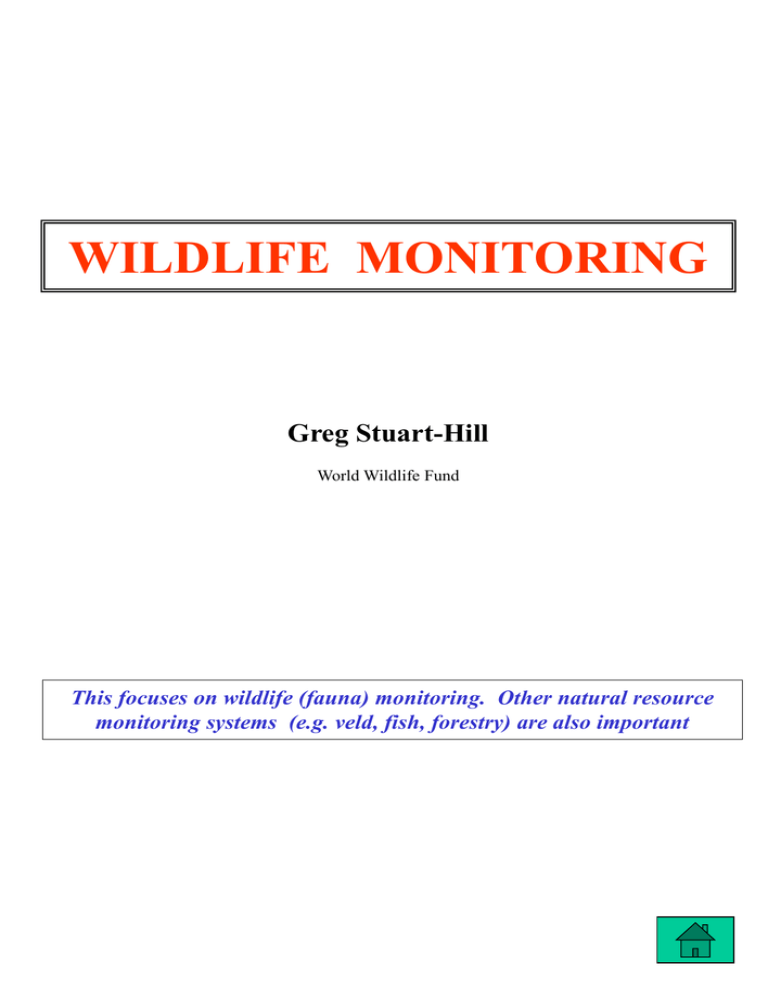
WILDLIFE MONITORING
Greg Stuart-Hill
World Wildlife Fund
This focuses on wildlife (fauna) monitoring. Other natural resource
monitoring systems (e.g. veld, fish, forestry) are also important
Monitoring is needed for adaptive
management
The context:
Set objectives
(land-use planning)
Manage according
to objectives
Yes
Monitor to
see if
objectives
being
achieved
Are
objectives being
achieved?
No
Modify
objectives or
management
What should be monitored?
1.1 Population Estimates
Need: To know how many animals there are, each year.
Why?
• To estimate off-take quotas, and
• To determine drought risk & livestock competition
How?
• Use road counts/aerial census/cybertracker counts
• Use correction-factors (eg transect width, distance, etc)
• For rare species (eg rhino) use known group/individuals
Datasheet:
Grid Cell/ GPS
Species Number
Distance
east
south
Notes (sex age structure, etc)
Output: ……..a Table for each year!
SPECIES
COUNT NUMBER
POPULATION
ESTIMATE
Kudu
254
300
Eland
116
150
Giraffe
23
50
Elephant
22
70
etc
etc
etc
Numbers are very difficult to obtain
– most census methods underestimate wildlife populations!
1.2 Population Trend
Need: to know what is happening to the wildlife populations.
Why? Is wildlife management sustainable
How? Fixed Foot Patrols, fixed road counts, Cybertracker
Counts and Aerial census.
Can use an index! ….... But sampling effort must be controlled ! …..
Datasheet:
FIXED FOOT PATROLS
OBSERVERS
DATE
ROUTE:
DISTANCE
START POSITION
END POSITION
START TIME
END TIME
Grid Cell/ GPS
Time
Species
Notes (sex age structure, etc)
Number
east
south
Output: …provide a graph for each species!
Zebra
Great!
Here’s a problem!
Kudu
Years
Counts do not have to be
‘accurate’ – a change in
an index over time is fine!
Years
Be careful of using the last point on the graph – this
could be an error - so check the sex-age information
1.3 Game Distribution
Need a Map showing where each species is concentrated
Why? To identify wildlife concentration areas for landuse planning purposes (also to see monitor distribution
changes over the years)
How? Use Cyber tracker or Grid blocks for all sightings
(NB also record where animals were not seen)
Data collection:
Grid Cell/ GPS
Species
Number Distance
Output:
Lets build a lodge
here because this
is where most of
the game is
Year 1
east
south
Notes (sex age structure, etc)
Why not put a borehole
here to utilize this area
Year 10
1.4 Sex-Age Ratio Monitoring
Need to determine ratios between adults, sub-adults an
juveniles
Why? Use this information as an early warning of the current
‘health’ of the wildlife population
Datasheet:
SEX-AGE SURVEY
Species
Total
Number
Ad-Male
AdFemale
SubAdults
Juvenile
Sex-age breakdown 2001
Output:
Young: Adult Ratio
• If the ratio of young to
adults diminishes then this
is an early warning that
the population is in
trouble
• If the ratio between subadults and juveniles
changes this gives an
indication of post breeding
survival ability – i.e. useful
to evaluate impact of
predation
Male : Female Ratio
Bulls
Cows
Sub-adult s Juveniles
It is necessary to know the ratio of Adult male to female
because:
• Live game capture/sale normally results in higher
proportions of females - with potentially devastating
impacts to the population
• To properly evaluate breeding success, you need to view
number of young in relation to the number of females
• For input into population modeling which is used to
predict population growth and future harvest potential
and stocking rates
2.1 Mortalities
Need: To keep track of mortalities
Why? To alert management if mortalities suddenly rise & plan
action based on the cause (e.g. poaching, disease, drought)
Datasheet:
MORTALITY LOG
NAME:
Unknow n
Natural
south
Predator
east
Poach
Species
> w eek
Date
Carcass age Cause of Death
< w eek
Grid Cell
Notes
Reported to…
Output 1: a Trend graph of mortalities over years
What is going on here? What is causing
these abnormally high mortalities?
Mortality
If sudden
Increase
Years
Output 2: Map showing where mortalities are
Also need to know the
cause of mortalities
(i.e. is it due to poaching,
disease, drought?)
But only if they these are
abnormally high
2.2 Poaching
Need: To track poaching as a threat to wildlife
Why? To understand the threat to wildlife and gauge
community support for the Conservancy
Datasheet:
POACHING LOG
NAME:
east
south
Output:
• Graph - is poaching
being controlled?
• Map - where poaching
is taking place?
• Table - who is
poaching & what is
being taken?
CATEGORY
Approx.
date of
incident
Notes (suspects,
arrests, etc)
Reported to…
Poaching is getting bad!
Poaching
If
Increasing
Cases
Meat
Commercial
Residents
2
1 kudu,
1 duiker
-
Neighbors
10
8 kudu,
1 giraffe
-
Other
Citizens
2
1 kudu
Non-citizens
Firearm
Species
Traditional
Date
Type of Incident
Snare
Grid Cell/ GPS
1 leopard
1 elephant, 1 rhino
Years
2.3 Problem Animals (PAC)
Need: To track problem animal incidents, identify those
species causing problems, evaluate damage caused & record
efforts that go into reducing conflict with problem animals
Why? To understand the impact of wildlife on people &
find ways to reduce conflict and compensate individuals.
How? Keep record of all PAC incidents. Track attempts to
reduce conflict (e.g. fencing, water protection, kraaling).
Datasheet:
PAC LOG
Village
Output:
Species Number
Type of
loss
ha
number
Reaction
Prevention
(kraal/fence)
Num Killed
Date
Extent of loss
Yes/No
Problem animal
Complainant
Complainant's
signature
2.4 Rainfall
Need: To track rainfall as a threat & opportunity for wildlife
Why? To separate the effects of rainfall from the impacts of
human activity on wildlife and help explain population trend
Datasheet:
Output:
Its been a good season!
• A Graph – is rainfall
above or below
average?
Years
• A Map - where did rain
fall or not fall?
2.5 Disturbance (e.g. livestock, cropping, tourists)
Need: To track other land-use activities such as cropping,
livestock farming, tourist activity
Why? To understand the threat of these disturbances and
gauge if these have impacted on wildlife
Data Collection:
•
•
•
•
•
Map areas of cropping and livestock farming
Map areas of tourism activity and keep track of tourism numbers on
various roads
Record ‘flight’ distance (at what distance does game raun away from a
vehicle) of game on an annual basis
Record how far wildlife will come within a homestead
Keep a note if animals only drink at night
Output:
Disturbance is affecting
the elephants
• Graph - Relate an index
of disturbance (e.g.
‘flight distance’ to
indices of human
impacts (e.g.
settlement, tourism,
etc).
• Map - Also compare wildlife distribution maps
with maps of human activity.
3.1 Game
Introductions & Removals
Need: To keep a record of how many animals are
Introduced or Removed
Why? To know if continued Introductions/Removals are
wise, & explain any changes in the population trend-graphs
How? Keep a record of all animals that are Introduced and
all animals that are Removed from the area.
Output: ………..a Table for each year!
SPECIES
Removed
Introduced**
Kudu
30
-
Eland
15
-
Giraffe
3
-
Zebra
-
100
Gemsbok
-
50
** Need to also check on success of each introduction
Also refer to the following pages in this manual for:
1. Game Removals
2. Game introductions
These pages will explain in greater detail the ‘Removal’
and ‘Introduction’ monitoring systems
3.1.1 Game Removals (“Harvesting”)
How?
Each time animals are removed (sold or hunted) keep a
record of:
• how many animals are removed against quota
• sex of removed animals
• for animals hunted, record trophies
Output: …..a Table for each year!
Quota
Removed
Male:Female
Kudu
40
30
20:10
Eland
15
15
10:5
Giraffe
3
3
3:0
Zebra
2
-
-
Gemsbok
5
-
-
SPECIES
(see ‘Trophy Quality’ in the
manual)
3.1.2 Game Introductions
How?
1. Keep a record of how many animals are introduced
2. Also check on the success (i.e. survival & breeding)
of each introduction by :
• Conducting sex-age survey to determine ratios
between adult females and young (see ‘sex-age
monitoring’ in this manual)
• Monitor marked (collared) animals to determine
survival rates and ensure they are still in the area.
Output: …Distribution map and a Table
SPECIES
Number
Introduced
Survival
Zebra
100
60%
Gemsbok
100
95%
OK!
Breeding
Adult:Young
100:40
OK!
100:3
If Survival Rates are less
than 90% for a species then a
mortality report should be
attached to the table
If Breeding Rates are less than a critical
level (level varies per species) then this
indicates that a species will not thrive
even though it survived survived the
introduction event
3.2 Trophy Quality
Need: to track change in Trophy Quality (e.g. tusk/horn size)
Why? Trophy hunting will not affect wildlife population
growth (excluding predators), but too much hunting results in
poor trophy size - this leads to a lower concession value.
How? From trophy hunter records
Datasheet:
Permit#
Species
Sex
Trophy (L)
Trophy (R)
Client
PH
Output:
…provide a trophy size trend graph for each species, over years!
Lower the elephant quota! - we have
taken too many.
Hunters can only find small tuskers
Tusk Size
Years
3.3 Tourist Satisfaction
Need to track game viewing success (i.e. number of
sightings, number of species, etc).
Why?
• know game viewing potential for planing & marketing,
• to evaluate whether each animal population is at
adequate numbers to satisfy tourists.
• to assess whether a problem species could be reduced
without harming game viewing
Datasheet:
Species
Sighting index
Comments of sighting satisfaction per species
Output:
… provide a ‘game viewing success’ graph for each species, over years!
We should re-introduce lions they are key to tourism and
are not being seen anymore
Lion
Years
If we reduce elephant
numbers it will save us a lot
of damage and have no
effect on game viewing
Elephant
Years
3.4 Water Points
Need: to closely monitor and repair any water installation,
particularly in the dry season.
Why? Water is critical to wildlife, people and livestock.
There is considerable conflict around this resource and so it is
essential to ensure that water installations function.
How? Each water point should be visited on a regular basis
and if necessary repairs made immediately.
Datasheets:
Protection against
Bore #
Locality
Date
Elephant
Theft
Presently
working?
Comments, including repairs if
any
Damage
by?
4.1 Important Species:
Population Performance
Need: To to track population performance of species such
as predators, elephant, rhino, disease free buffalo, etc
Why? To know how many there are and how their
populations are performing.
How? Normal count methods do not work for rare or
nocturnal species. Use specially designed systems (e.g.
radio tracking, known group). This usually involves
specialist research teams from MET, SRT, etc.
Output:
Rhino inter-calving period is
suddenly increasing. There
seems to be a problem ?
Years
4.2 Important Species:
Body-Condition
Need: To track body condition of critical species such as
Rhino, disease free Buffalo, Roan, etc
Why? To serve as an early warning of a nutritional (drought)
problem.
How? Estimate body fat on a sample of animals each month
and graph.
Output:
Lets provide extra feed for the buffalo!
I foresee problems this winter
Body Fat
Years

